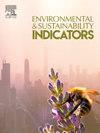中国自由贸易试验区如何实现高质量发展?以天津市为例
IF 5.6
Q1 ENVIRONMENTAL SCIENCES
引用次数: 0
摘要
中国自由贸易试验区的高质量发展是经济转型的必要条件,也是实现可持续发展目标的有力支撑。然而,有限的研究系统地探讨了在不同制度和环境背景下高质量发展的多维驱动因素。本文以天津自由贸易试验区为研究对象,探讨其关键影响因素和配置路径。采用技术-组织-环境(TOE)框架、层次分析法-模糊综合评价(AHP-FCE)和模糊集定性比较分析(fsQCA)相结合的混合方法,对2016年至2024年的官方统计数据和针对性调查反馈数据进行了分析。结果表明,天津自由贸易试验区微观层面的平均质量得分为3.26分,总体上有所提高,但在创新、绿色金融和监管能力方面存在不足。确定了实现高质量的四种配置路径,而三种不同的非高质量路径揭示了路径不对称,表明不对称因果关系。值得注意的是,在大多数高质量配置中,全面的环境监管是一个重要因素。这些研究成果为推进自由贸易试验区多元化高质量发展战略提供了理论和实践见解,为实现联合国可持续发展目标提供了实证支持。本文章由计算机程序翻译,如有差异,请以英文原文为准。
How can China's pilot free trade zones achieve high-quality development? Take Tianjin City as an example
High-quality development of China's pilot free trade zones is essential for economic transformation and supports progress to the Sustainable Development Goals (SDGs). However, limited research has systematically explored the multi-dimensional drivers of high-quality development under varying institutional and environmental contexts. This paper focuses on the Tianjin Pilot Free Trade Zone to investigate key influencing factors and configuration paths. A hybrid method integrating the Technology–Organization–Environment (TOE) framework, Analytic Hierarchy Process–Fuzzy Comprehensive Evaluation (AHP-FCE), and fuzzy-set Qualitative Comparative Analysis (fsQCA) was applied to data from 2016 to 2024, including official statistics and targeted survey responses. Results show the Tianjin Pilot Free Trade Zone's average micro-level high-quality score is 3.26, reflecting overall improvement but revealing deficiencies in innovation, green finance, and regulatory capacity. Four configuration paths were identified for achieving high-quality, while three distinct non-high-quality paths reveal path asymmetry, indicating asymmetric causal relationships. Notably, comprehensive environmental regulation is an important factor across most high-quality configurations. These findings offer theoretical and practical insights for advancing diversified high-quality development strategies in pilot free trade zones and contribute evidence-based support for achieving the United Nations' Sustainable Development Goals.
求助全文
通过发布文献求助,成功后即可免费获取论文全文。
去求助
来源期刊

Environmental and Sustainability Indicators
Environmental Science-Environmental Science (miscellaneous)
CiteScore
7.80
自引率
2.30%
发文量
49
审稿时长
57 days
 求助内容:
求助内容: 应助结果提醒方式:
应助结果提醒方式:


